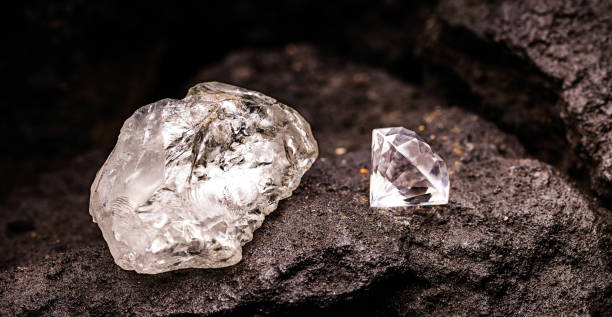The Diamond Mining Industry: Process, Environmental Impact, and Ethical Concerns
Diamond mining is one of the most lucrative yet controversial industries in the world. Diamonds, formed deep within the Earth’s mantle under extreme heat and pressure, are brought to the surface through volcanic eruptions. These precious stones are highly valued for their brilliance, hardness, and symbolic meaning in jewelry, particularly in engagement rings. However, the process of extracting diamonds involves significant environmental, social, and ethical challenges. This article explores the diamond mining process, its economic importance, environmental consequences, and the ethical issues surrounding "blood diamonds."
The Diamond Mining Process
Diamond mining involves several methods, depending on the location and geological conditions. The four primary methods are:
1. Open-Pit Mining
Open-pit mining is the most common method for extracting diamonds near the Earth’s surface. Large craters are dug using heavy machinery, explosives, and trucks to remove layers of soil and rock. Once the diamond-bearing ore (kimberlite or lamproite) is exposed, it is transported to processing plants where diamonds are separated from other minerals.
Major open-pit diamond mines include the Mir Mine in Russia and the Jwaneng Mine in Botswana, one of the richest diamond mines in the world.
2. Underground Mining
When diamond deposits are too deep for open-pit mining, underground mining is used. Miners dig tunnels and shafts to reach diamond-bearing ore. This method is more expensive and dangerous due to the risk of collapses and gas explosions.
The Cullinan Mine in South Africa, famous for producing the largest gem-quality diamond ever found (the 3,106-carat Cullinan Diamond), operates using underground mining.
3. Alluvial Mining
Alluvial mining involves extracting diamonds from riverbeds, beaches, and other sedimentary deposits where erosion has carried them away from their original volcanic pipes. Miners use sieves, pans, and dredges to separate diamonds from gravel and sand.
Countries like Sierra Leone, Angola, and Brazil have significant alluvial diamond deposits, often mined by artisanal miners in small-scale operations.
4. Marine Mining
Marine diamond mining extracts diamonds from the ocean floor using specialized ships with crawlers that suck gravel from the seabed. The gravel is then processed to retrieve diamonds.
Namibia is a leader in marine diamond mining, with companies like Debmarine Namibia operating advanced offshore extraction vessels.
Economic Importance of Diamond Mining
Diamond mining contributes significantly to the economies of several countries, particularly in Africa.
Botswana: Diamonds account for about 80% of export earnings and have helped transform the country from one of the poorest to a middle-income nation.
Russia: Home to Alrosa, the world’s largest diamond producer, Russia supplies nearly 30% of global diamond production.
Canada: A major ethical diamond producer, Canada’s mines, such as Diavik and Ekati, provide high-quality diamonds under strict labor and environmental regulations.
Despite its economic benefits, diamond mining has also fueled corruption, conflict, and inequality in some regions.
Environmental Impact of Diamond Mining
Diamond mining has severe environmental consequences, including:
1. Deforestation and Land Degradation
Open-pit mining destroys large areas of land, leading to deforestation and habitat loss. In countries like the Democratic Republic of Congo (DRC), mining has contributed to the decline of endangered species.
2. Water Pollution
Chemicals used in diamond processing, such as sulfuric acid and mercury, can contaminate rivers and groundwater, affecting both wildlife and local communities.
3. Carbon Emissions
Heavy machinery, explosives, and transportation contribute to greenhouse gas emissions. Additionally, marine diamond mining disrupts ocean ecosystems.
4. Soil Erosion
Removing vegetation and digging deep pits lead to soil erosion, making land unsuitable for agriculture.
Efforts to mitigate these impacts include land rehabilitation, water treatment systems, and stricter environmental regulations. Some companies now invest in carbon-neutral mining and synthetic diamonds as a more sustainable alternative.
Ethical Issues: Blood Diamonds and Human Rights Violations
One of the darkest aspects of diamond mining is the trade in "blood diamonds" (conflict diamonds)—gems mined in war zones and sold to finance armed conflicts.
1. The Role of Blood Diamonds in African Conflicts
During the 1990s and early 2000s, rebel groups in Sierra Leone, Angola, and Liberia used diamond sales to buy weapons, leading to brutal civil wars. Thousands were killed, and many more were forced into slave labor in mines.
2. The Kimberley Process Certification Scheme (KPCS)
Established in 2003, the Kimberley Process aims to prevent conflict diamonds from entering the market. However, critics argue that it has loopholes, allowing diamonds mined under abusive conditions to still be certified as "conflict-free."
3. Child Labor and Exploitation
In countries like the DRC and Zimbabwe, children are often forced to work in dangerous mining conditions for little or no pay. Reports of beatings, sexual violence, and deaths in mines continue to surface.
4. The Rise of Ethical and Lab-Grown Diamonds
Due to these concerns, many consumers now prefer lab-grown diamonds or diamonds certified by organizations like the Responsible Jewellery Council (RJC). Companies like De Beers now offer synthetic diamonds as a more ethical alternative.
The Future of Diamond Mining
The diamond industry faces pressure to adopt more sustainable and ethical practices. Key trends include:
Blockchain Tracking: Companies like De Beers (Tracr) use blockchain to trace diamonds from mine to market, ensuring ethical sourcing.
Lab-Grown Diamonds: These diamonds, chemically identical to natural ones, are gaining popularity due to their lower environmental impact.
Stricter Regulations: Governments and NGOs are pushing for stronger enforcement of labor and environmental laws in mining.

Posting Komentar untuk "The Diamond Mining Industry: Process, Environmental Impact, and Ethical Concerns"
Posting Komentar